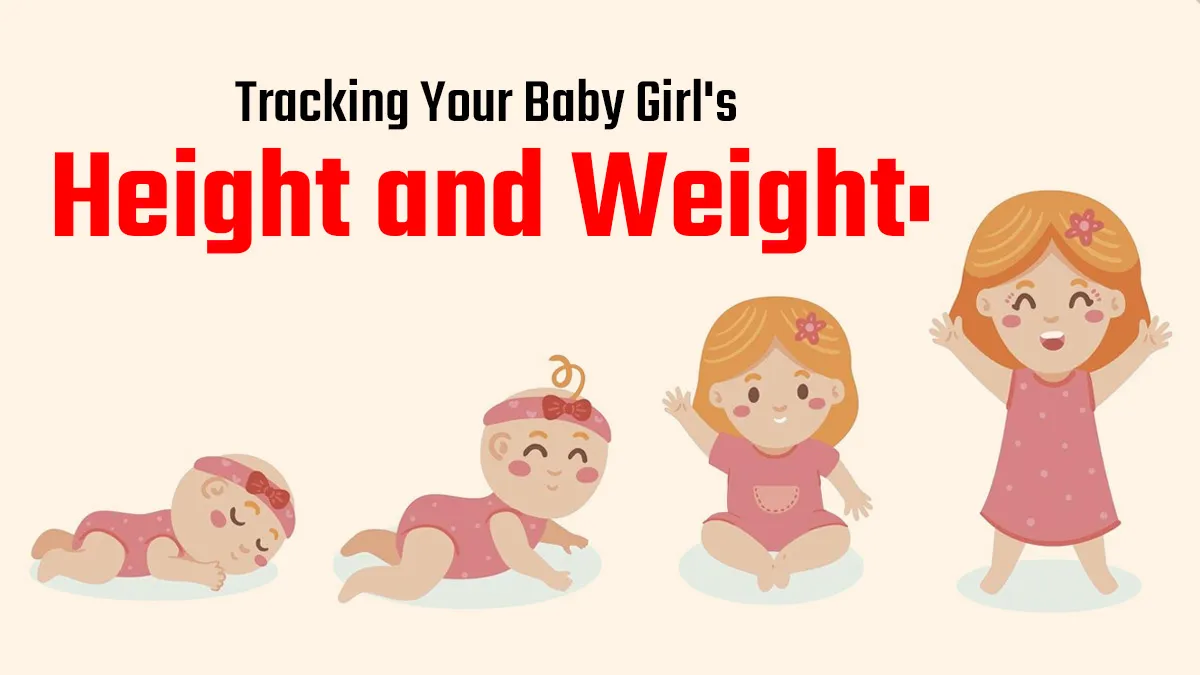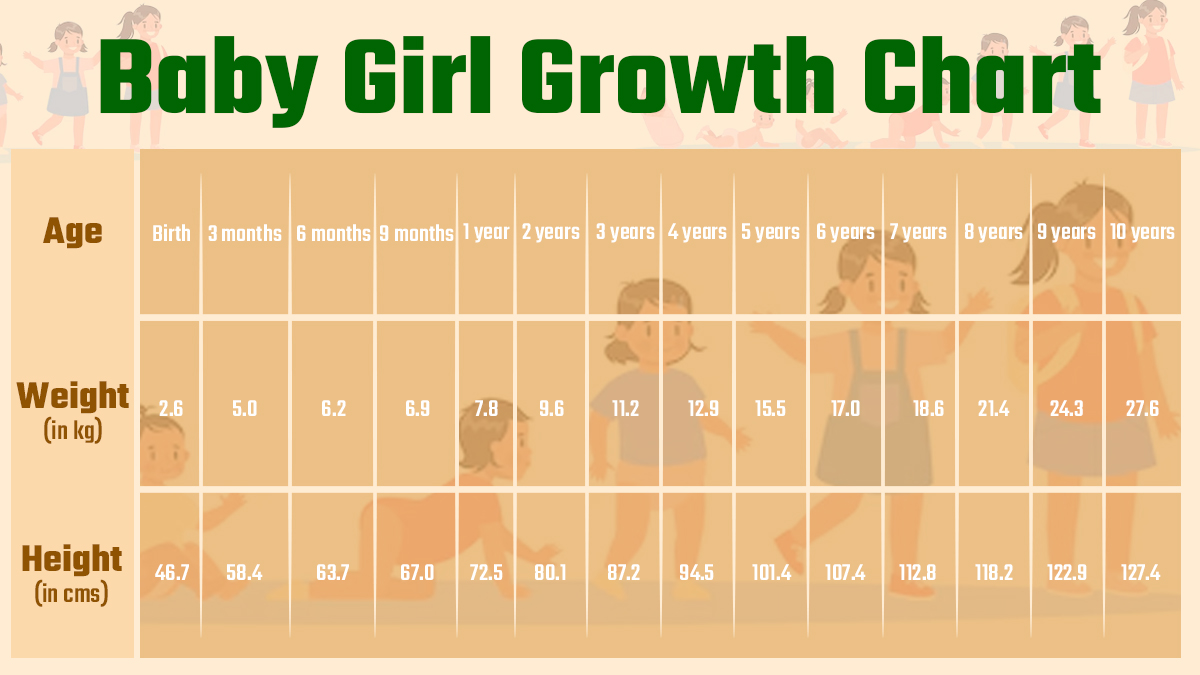
Watching your baby girl grow during her first few years is an exciting and sometimes nerve-wracking journey. The interval between 12-24 months denotes a shift from infancy to early childhood, characterised by significant physical and intellectual milestones. As a parent, it’s natural to want to track her progress, especially when it comes to height and weight. Growth charts can help give you a sense of how she’s doing, but remember, every child grows at their own pace. This stage marks the transition from infancy to early childhood, so changes in growth are normal. With the right nutrition, regular check-ups, and lots of love, you can support her healthy development every step of the way.
Table of Content:-

Development refers to both growth and function. It involves the maturation and myelination of the nervous system, as well as acquiring various skills for the body's function. “During early pregnancy, fetal cells divide and differentiate to form tissues and organs. In the later stages of pregnancy and early childhood, cell size increases. Body cells maintain a dynamic balance, with ageing cells being continuously replaced by new ones,” explained Professor Dr Sandeep Rajput, HOD Paediatrics, YMT Ayurvedic Medical College, Kharghar, GD Pol Foundation.
According to a study published in Human Growth and Development, the first year of life is when babies experience the fastest growth. It’s normal for babies to lose up to 7% of their birth weight in the first few days, but they usually regain it by the 14th day. In the first year, babies typically grow about 25 cm, with an average growth rate of 18 cm per year during infancy. Their weight also increases significantly, with most babies gaining up to 7 kg in the first year.
Growth Parameters for Baby Girls (12-24 Months)
Growth charts serve as invaluable tools for assessing whether a baby’s development aligns with expected patterns. While not perfect, they provide a general framework to evaluate trends over time. Dr Vittal Kumar Kesireddy, Consultant and In-Charge, Department of Paediatrics, CARE Hospitals, Banjara Hills, Hyderabad, shares a month-by-month guide of standard height and weight for baby girls ages 12-24 months, along with suggestions to nurture healthy growth.
12-15 Months

- Height: Approximately 74.0 to 77.5 cm (29.1 to 30.5 inches)
- Weight: Approximately 8.9 to 10.2 kg (19.6 to 22.5 pounds)
During this period, your baby girl is likely taking her first steps and exploring her surroundings with curiosity. Growth rates are slow compared to the first year but remain steady. A balanced diet rich in calcium, iron, and proteins is crucial to support bone development and muscle strength. Include foods like dairy, leafy greens, and lentils in her meals.
Also Read: Baby Boy Height and Weight Growth Chart for 12 to 24 Months From Paediatrician
16-18 Months
- Height: Approximately 78.0 to 80.5 cm (30.7 to 31.7 inches)
- Weight: Approximately 10.0 to 11.0 kg (22 to 24.2 pounds)
As motor skills improve, your toddler’s activity levels increase. This stage sees refined walking, running, and climbing abilities. Growth continues steadily, and ensuring a diet that includes whole grains, fresh fruits, and vegetables is essential for her energy needs. Offer small, frequent meals to accommodate her developing appetite.
19-21 Months

- Height: Approximately 81.0 to 83.5 cm (31.9 to 32.9 inches)
- Weight: Approximately 10.8 to 11.8 kg (23.8 to 26 pounds)
Your baby girl’s vocabulary and communication skills expand significantly during this time. Physical growth remains consistent, but there might be slight variations depending on genetic factors. Outdoor activities, playtime, and interaction with peers help enhance her coordination and social skills. Ensure hydration and limit sugary beverages.
22-24 Months
- Height: Approximately 84.0 to 86.5 cm (33.1 to 34.1 inches)
- Weight: Approximately 11.6 to 12.5 kg (25.6 to 27.6 pounds)
By the time she approaches her second birthday, your toddler’s growth will start to resemble more gradual progress. A nutrient-dense diet with healthy fats, omega-3 fatty acids, and sufficient protein supports brain development and physical growth. This is also the right time to establish routines around meal times and physical activity.
Interpreting Growth Charts
Growth charts are valuable tools that use percentiles to compare a child's measurements with reference data. A measurement in the 50th percentile indicates an average size for that age. Consistently following the same percentile line over time typically signals healthy growth.
Factors Affecting Growth
There are mainly three factors that affect the growth of a child. Dr Rajput breaks it down for you:
- Foetal Growth
- Postnatal Growth
- Social Factors
1. Foetal Growth Factor

- Genetic potential: Parental traits are often passed down to their children. A tall parent is likely to have a tall child.
- Sex: Boys are taller and weigh heavier than girls
- Foetal Hormones: Thyroxine and insulin play key roles in growth and development, while glucocorticoids are especially important towards the end of gestation.
- Foetal Growth factors: The insulin, like growth factor (IGF)-1 and (IGF)-II are the most extensively studied foetal growth factors.
- Placental factors: Foetal growth is highly dependent on the structural and functional integrity and the placenta.
- Maternal Factors: A mother's diet and nutrient intake during pregnancy play an important role in determining the lifelong well-being of her children.
Also Read: Worried About Your Newborn’s Nutrition? Here Are The Surprising Benefits Of Millet
2. Postnatal Period
- Sex: Pubertal growth occurs earlier in girls than boys.
- Genetic factors: Mutations in single or multiple genes may result in inherited retardation and growth issues. For example, Prader-Willi syndrome and Noonan syndrome.
- Hormonal Influence: Hormones can promote somatic and skeletal growth.
- Nutrition: Vitamin deficiencies are closely related to disorders of growth and development while overeating is closely linked to obesity, which can accelerate somatic growth.
- Infections: It is one of the most common contributors to poor childhood growth.
- Trauma: Damage to the growing epiphysis of bone thus hampering the skeletal growth.
3. Social Factors
- Poverty: Hunger undernutrition is closely associated with poverty.
- Climates: Growth rate can vary with the seasons, normally higher in winter and lower in summer.
- Cultural Factors: Religious taboos or cultural beliefs may restrict the consumption of certain foods, which can impact nutritional status and, consequently, growth.
Rules Of Thumb for Growth
Weight

- Every newborn loses 5-10% of their birth weight in the first 10 days of life.
- Newborns usually recover their birth weight within the first 10 days after birth.
- Birth weight generally doubles by 4-5 months.
- A baby's birth weight generally increases to three times its original weight by the time they turn one year old.
Daily Weight Gain
- 20-30 gm for the first 3-4 Months.
- 15-20gm for rest and the first year.
Height
- We can calculate height by using the following formula.
- Father height +Mother height/2+- 6cms

Signs to Monitor
While most variations in growth are normal, parents should seek medical advice if:
The child’s weight or height falls below the 3rd percentile or above the 97th percentile.
There are sudden drops or plateaus in growth patterns.
There are clear signs of developmental delays, such as challenges with walking or speaking.
Bottomline
The journey from 12-24 months is a transformative period for your baby girl, with growth rates stabilising and developmental milestones unfolding. Growth charts provide an excellent way to track progress and identify potential concerns early. However, remember that every child is unique, and small deviations from standard benchmarks are often normal.
[Disclaimer: This article contains information provided by an expert and is for informational purposes only. Hence, we advise you to consult your professional if you are dealing with any health issues to avoid complications.]
Also watch this video
How we keep this article up to date:
We work with experts and keep a close eye on the latest in health and wellness. Whenever there is a new research or helpful information, we update our articles with accurate and useful advice.
Current Version